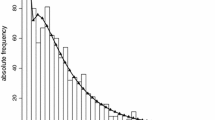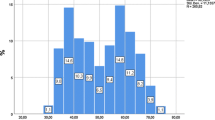Abstract
This work analyses the links between individual research performance and academic rank. A typical bibliometric methodology is used to study the performance of all Italian university researchers active in the hard sciences, for the period 2004–2008. The objective is to characterize the performance of the ranks of full (FPs), associate and assistant professors (APs), along various dimensions, in order to verify the existence of performance differences among the ranks in general and for single disciplines.
Similar content being viewed by others
Notes
Since MIUR financing composes 55.5% of the total, the share that is distributed on the basis of the VTR represents 3.9% of total income.
Standardization of citations with respect to median value rather than to the average (as frequently observed in literature) is justified by the fact that distribution of citations is highly skewed in almost all disciplines.
For life sciences, different weights are given to each co-author according to his/her position in the list and the character of the co-authorship (intra-mural or extra-mural). If first and last authors belong to the same university, 40% of citations are attributed to each of them; the remaining 20% are divided among all other authors. If the first two and last two authors belong to different universities, 30% of citations are attributed to first and last authors; 15% of citations are attributed to second and last author but one; the remaining 10% are divided among all others.
Gini coefficient is the most commonly used measure of inequality. It varies between 0, which reflects complete equality and 1, which indicates complete inequality (one person has all the measure, all others have none).
Concentration indexes represent a measure of association between two variables based on frequency data, varying around the neutral value of 1. For example, in mathematics and computer science, the value of 1.05 derives from the ratio of two percentages: full professor-top scientists over all top scientists of the UDA (39.1%), divided by full professors over total academic staff of the UDA (37.2%).
References
Abramo, G., & D’Angelo, C. A. (2011). National-scale research performance assessment at the individual level. Scientometrics, 86(2), 347–364.
Abramo, G., D’Angelo, C. A., & Di Costa, F. (2008). Assessment of sectoral aggregation distortion in research productivity measurements. Research Evaluation, 17(2), 111–121.
Blackburn, R. T., Behymer, C. E., & Hall, D. E. (1978). Research notes: Correlates of faculty publication. Sociology of Education, 51(2), 132–141.
Carayol, N., & Matt, M. (2006). Individual and collective determinants of academic scientists’ productivity. Information Economics and Policy, 18(1), 55–72.
Cole, S. (1979). Age and scientific performance. The American Journal of Sociology, 84(4), 958–977.
Costas, R., van Leeuwen Thed, N., & Bordons, M. (2010). A bibliometric classificatory approach for the study and assessment of research performance at individual level: The effect of age on productivity and impact. Journal of the American Society for Information Science and Technology, 61(8), 1564–1581.
D’Angelo, C. A., Giuffrida, C., & Abramo, G. (2010). A heuristic approach to author name disambiguation in bibliometrics databases for large-scale research assessments. Journal of the American Society for Information Science and Technology, 62(2), 257–269.
Gingras, Y., Larivière, V., Macaluso, B., & Robitaille, J. P. (2008). The effects of aging on researchers’ publication and citation patterns. PLoS ONE, 3(12), e4048.
Glänzel, W. (2008). Seven myths in bibliometrics. About facts and fiction in quantitative science studies. In H. Kretschmer & F. Havemann (Eds.), Proceedings of WIS 2008, Berlin Fourth International Conference on Webometrics, Informetrics and Scientometrics & Ninth COLLNET Meeting. Humboldt-Universität zu Berlin, Institute for Library and Information Science (IBI). Open Access document licensed under the Creative Commons License.
Kyvik, S., & Olsen, T. B. (2008). Does the aging of tenured academic staff affect the research performance of universities? Scientometrics, 76(3), 439–455.
Lissoni, F., Mairesse, J., Montobbio, F., & Pezzoni, M. (2011). Scientific productivity and academic promotion: A study on French and Italian physicists. Industrial and Corporate Change, 20(1), 253–294.
Miur (2010). Decimo rapporto sullo stato del sistema universitario. Last accessed June 14, 2011 from http://www.cnvsu.it/library/downloadfile.asp?id=11668.
Moed, H. F. (2008). UK research assessment exercises: Informed judgments on research quality or quantity? Scientometrics, 74(1), 153–161.
Shin, J. C., & Cummings, W. K. (2010). Multilevel analysis of academic publishing across disciplines: Research preference, collaboration, and time on research. Scientometrics, 85(2), 581–594.
Ventura, O. N., & Mombrù, A. W. (2006). Use of bibliometric information to assist research policy making. A comparison of publication and citation profiles of Full and Associate Professors at a School of Chemistry in Uruguay. Scientometrics, 69(2), 287–313.
Author information
Authors and Affiliations
Corresponding author
Rights and permissions
About this article
Cite this article
Abramo, G., D’Angelo, C.A. & Di Costa, F. Research productivity: Are higher academic ranks more productive than lower ones?. Scientometrics 88, 915–928 (2011). https://doi.org/10.1007/s11192-011-0426-6
Received:
Published:
Issue Date:
DOI: https://doi.org/10.1007/s11192-011-0426-6




